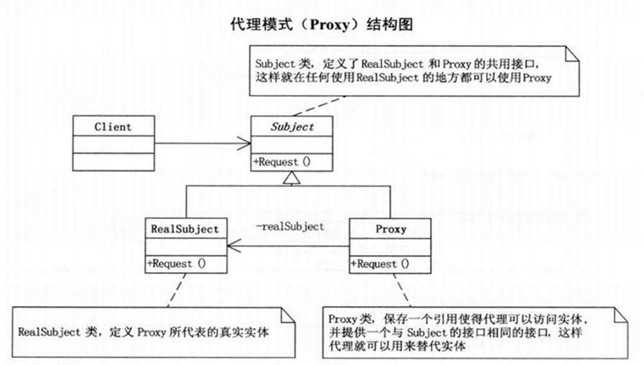标签:spro blog group proxy hashcode ide arguments cat stack
图截于《大话设计模式》

Proxy模式是常用的设计模式,其特征是代理类与委托类有同样的接口,代理类主要负责为委托类预处理消息、过滤消息、把消息转发给委托类,以及事后处理消息等。
用户可以更加结构图,自己编码完成Proxy模式。这种实现称为静态代理。
Java提供了java.lang.reflect.Proxy类与InvocationHandler接口,配合反射,可以实现动态代理。静态代理的代理类与代理操作,都是事先编码,运行过程种无法修改代理结构。动态代理的代理与代理操作,都是在运行过程中,动态生成,可以在运行过程中,修改代理结构。
InvocationHandler类提供代理操作行为,动态构建的代理类使用该接口调用代理操作。
Proxy类主要负责动态构建代理类,有以下静态方法:
调用getProxyClass()会动态生成Proxy类的子类,并使用loader参数指定的类加载器加载;第二个参数interfaces指定该子类将要继承的接口,可以指定多个接口。
|
interface Foo { void funcA(); }
Class<?> proxyClass = Proxy.getProxyClass(Foo.class.getClassLoader(), Foo.class); System.out.println(proxyClass.getName()); for (Class<?> interfaceType : proxyClass.getInterfaces()) System.out.println("\t" + interfaceType);
Class<?> proxyClassB = Proxy.getProxyClass(Foo.class.getClassLoader(), Foo.class, AutoCloseable.class); System.out.println(proxyClassB.getName()); for (Class<?> interfaceType : proxyClassB.getInterfaces()) System.out.println("\t" + interfaceType); |
输出如下:
|
testproxy.$Proxy0 interface testproxy.Foo testproxy.$Proxy1 interface testproxy.Foo interface java.lang.AutoCloseable |
由输出可以推测,调用Proxy.getProxyClass()后,生成子类为:
|
$Proxy* extends Proxy implements interfasces |
*为从0开始编号的整数,代表是第几个被创建的Proxy的子类。interfaces是Proxy.getProxyClass()方法的第二个不定参数。这些类的字节码创建在内存中。例如上面代码生成的子类为:
|
$Proxy0 extends Proxy implements Foo {...} $Proxy1 extends Proxy implements Foo, AutoCloseable {...} |
实现同接口的Proxy子类,只会被创建一次,拥有共同的Class实例。
|
Class<?> proxyClassA = Proxy.getProxyClass(Foo.class.getClassLoader(), Foo.class); Class<?> proxyClassB = Proxy.getProxyClass(Foo.class.getClassLoader(), Foo.class); System.out.println(proxyClassA.getName()); System.out.println(proxyClassB.getName()); |
输出如下:
|
testproxy.$Proxy0 testproxy.$Proxy0 |
由于Proxy类只有一个带InvocationHandler接口的参数,所有所以需要获取指定版本的构造函数后,传入InvocationHandler接口的实现类获取动态子类的实例。
|
Foo fooProxy = (Foo) proxyClass.getConstructor(InvocationHandler.class) .newInstance(handler); |
Proxy类提供的Proxy.newProxyInstance(),一步到位,简化了获取动态子类实例的操作。
|
Foo fooProxy = (Foo) Proxy.newProxyInstance(Foo.class.getClassLoader(), new Class<?>[] { Foo.class }, handler) |
fooProxy的实例为"$Proxy0 extends Proxy implements Foo {...}"类
InvocationHandler接口有一个invoke()方法需要实现,动态代理类正式调用这个方法执行代理操作。举个例子:
|
class SimpleHandler implements InvocationHandler { final private Object target;
public SimpleHandler(Object target) { // *需要保留委托类的引用 this.target = target; }
@Override public Object invoke(Object proxy, Method method, Object[] args) throws Throwable { System.out.println("---Proxy before---"); // *不适用第一个参数proxy,使用构造函数保留的引用调用委托类方法 Object result = method.invoke(target, args); System.out.println("---Proxy end---");
return result; } } |
使用以下委托类和代码测试。
|
class FooImp implements Foo { @Override public void funcA() { System.out.println("FooImp"); } }
// Test Foo fooProxy = (Foo) Proxy.newProxyInstance(Foo.class.getClassLoader(), new Class<?>[] { Foo.class }, new SimpleHandler(new FooImp())); fooProxy.funcA(); System.out.println(fooProxy.toString()); |
输出如下:
|
---Proxy before--- FooImp ---Proxy end--- ---Proxy before--- ---Proxy end--- testproxy.FooImp@4aa298b7 |
fooProxy的是实例是Proxy类的动态子类,调用该子类的funcA()方法时,实际上先调用了invoke()方法,再通过反射调用委托类的funcA()方法。
为什么toString()方法也被代理了?
实际上,Object的equal()、hashCode()也同时被代理的,这个与Proxy子类的构建过程有关,可以参考资料《JDK动态代理实现原理》。
实现InvocationHandler接口时,红色的注释指出两个疑点:
这个两个问题其实是一个问题,invoke()函数的第一个参数proxy引用的实例是Proxy类的动态子类,而不是委托类。如果使用反射调用动态子类的方法,又会再次调用invoke()函数,陷入无限循环中,直到内存移除崩溃。因此,需要保留委托类的引用,让invoke()方法可以调用到委托类的方法。这样又引出一个问题,proxy参数又什么用?
proxy参数可以做为返回值,实现方法链。具体可以参考《Understanding "proxy" arguments of the invoke method of java.lang.reflect.InvocationHandler》
标签:spro blog group proxy hashcode ide arguments cat stack
原文地址:https://www.cnblogs.com/foundkey/p/9795151.html